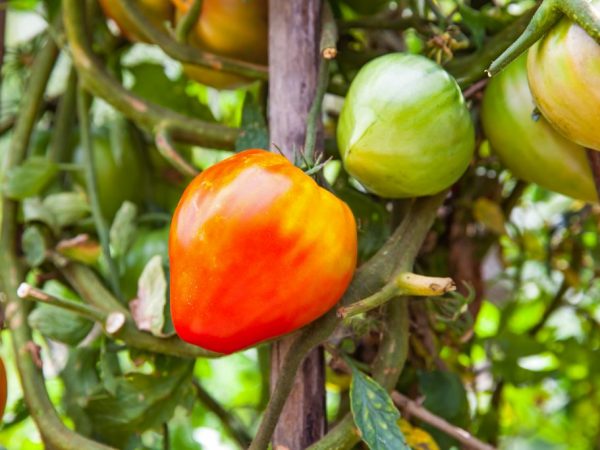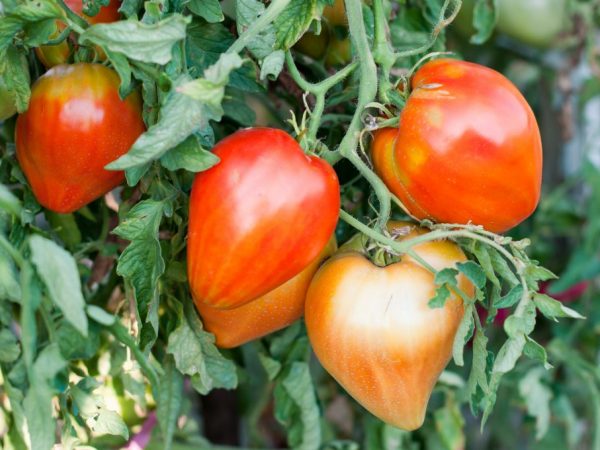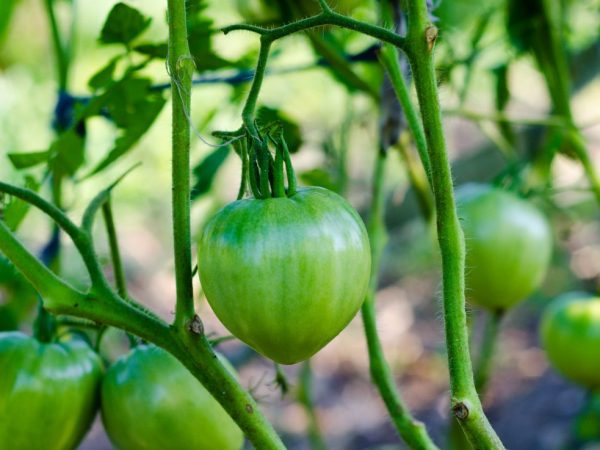Description and characteristics of the variety of tomatoes Bull heart
A giant tomato with an amazing taste (sweetish at the first bite and a sour aftertaste) - a bovine heart tomato is an amazing creation of breeders. Why is the variety so attractive? Is it possible to grow it yourself in the garden or does the plant require a whole range of complex agrotechnical procedures?

Description of the variety of tomatoes Bovine heart
Features of the variety
Tomatoes Bull's Heart are large-fruited varieties entered in the State Register in 2003 and recommended for cultivation both in open and closed ground, respectively, suitable for central Russia and the southern regions.
The "Bull Heart" varieties are mid-season (plants begin to bear fruit 120-130 days after germination). The yield indicator never ceases to amaze gardeners:
- in a greenhouse up to 10 kg from 1 bush;
- when grown outdoors - up to 3.5 kg per bush.
The plant is called low-leafed, this is due to the characteristics of the fruit and the specifics of care. Derived varieties "Bull Heart" are known all over the world due to the meatiness and extraordinary taste characteristics of tomatoes.
Average fruit description:
- heart-shaped;
- large sizes;
- poured red;
- thin peel;
- low-water pulp with a large amount of dry impurities;
- the minimum number of veins;
- seed chambers are present in small quantities (up to 5 pieces) and are located near the peel;
- few seeds;
- useful composition (vitamins, minerals, polysaccharides, fiber, folic, nicotinic and ascorbic acids);
- the pulp is sweetish due to the high sugar content;
- high keeping quality, good transport tolerance;
- large mass (tomatoes taken from the lower parts of the bush reach 500 g, from the upper ones - no more than 150-200 g).
There are known cases of obtaining tomatoes, the weight of which reaches 1 kg (with proper agricultural technology, specimens with a weight of 600-700 grams each are not rare). In this case, the height of the bush can reach 1.5-2 m.
Important: the plant and tomatoes are resistant to transportation and disease-causing parasites. As an exception, it is worth pointing out phytophthora, the development of which is difficult to prevent even for an experienced gardener.
Scope of use of tomatoes
Exquisite taste characteristics make it possible to use tomatoes not only for fresh consumption, but also for preservation, making fries, dressings, sauces, pastes, etc. It is better to heat-treat soft fruits (kept for a couple of weeks in a cool place).
It is worth noting that due to the large size of tomatoes, it is unprofitable to preserve them (you have to cut them, thereby reducing the shelf life of the workpieces).
Analogues of the "Bull's Heart" tomato variety

Analogues differ in fruit color
It is worth noting that the bull's heart tomatoes have a lot of f1 (French, Dutch) analogues, with similar characteristics.It is not so difficult to distinguish them from the original, because it is enough to pay attention to the color of the fruit: orange bull heart, pink and red are original varieties recorded in the State Register and hybrids with a unique color - yellow, white and even black “bull hearts”.
| Analogs | The timing of the ripening of tomatoes | Harvest characteristics | Tomato weight, g |
| Red bull heart ("Riviera") | Average | 2 harvest waves, bright scarlet oval fruits | Up to 700 g in the first wave and up to 350 g in the second |
| Orange bull heart | Average | Orange color and high fruit preservation | 300-800 g |
| Pink ("Babushkino") | Late | Seeds are practically absent, practically not susceptible to diseases (even late blight) | When first harvested up to 900 g, then reduced to 200 g |
| Raspberry (giant subspecies) | Shorter than pink | Characteristics similar to the previous variety: high resistance to pathogenic bacteria, delicate pulp, practically no seeds | Up to 800 g |
| Giant black | Late | Dark burgundy color, heart-shaped, 2 tomatoes per brush. Plant height up to 2 m | 400-600 g |
| Gold | Middle | Cone-shaped, fleshy | Up to 600 g, gradually decreasing to 100 g with subsequent harvests |
| Yellow (Minusinsk) | Middle | Sour aftertaste, color reminiscent of "White bull heart" with a slight yellowness | Up to 400 g |
Growing features
Growing bull heart tomatoes is quite laborious. Starts with sowing seeds in early spring:
- Treatment of seeds with a weak solution of potassium permanganate (1 g of substance per glass of water).
- Place the seeds to a depth of 3 cm.
- They dive after the appearance of the second leaf.
Planting in the ground or greenhouse is possible for a period of one and a half months to two from the moment of planting the seeds. Before moving to the garden plot, the seedlings are hardened.

The plant needs a lot of space
Planting time for tomatoes:
- in simple greenhouses - early May;
- rooms with temperature controllers - early April;
- open ground - early summer.
It is worth noting that the plant does not like cramped conditions, therefore, it is advisable to leave 2 seedlings per 1 m2 in the greenhouse, the number of seedlings on the ground can be doubled.
Important: the acidity of the soil should not be higher than 5.5. It is allowed to plant a plant in the beds after cabbage, carrots or onions. Solanaceous predecessors are fatal to the bovine heart.
For the best formation of the bush, it is important to tie it up and immediately remove the lower leaves. The number of brushes should not exceed 8-9 per bush.
To get the declared yield, it is enough to help with pollination (spray water in large drops and gently knock on the support of the plant), make timely pinching. Do not forget about fertilizers: a mixture of superphosphate and potassium sulfate, phosphorus additives.
Growing a bovine heart is a laborious process that requires special attention from the gardener. However, the result (high yield) is worth all the costs.
Disease and pest resistance
A large plant is resistant to many diseases, the only exception is late blight. This is a kind of deadly defeat of the bush itself with the fruits of the late blight fungus, which develops with improper crop care. The signs of the disease are:
- Increased rotting of stems, leaves and fruits.
- The specificity of localization and spread of lesions. The plant begins to rot not from the roots, but from the leaves, then the fruits suffer, and only then the deadly late blight disease affects the stem.
- Darkening and bridging of inflorescences.
The disease is quite contagious, therefore, in order to get rid of it, you will have to say goodbye to the affected bushes (dig them up, take them away from the garden and burn them).
Preventive measures to prevent the development of late blight are:
- airing the greenhouse;
- drying of seedlings (removal of concentrate from the surface of plants and walls of the shelter);
- full care and thinning of planting (elimination of weak and affected specimens).
Pros and cons of the variety
After examining the reviews of gardeners involved in the cultivation of the bull's heart tomato, we can safely highlight the pros and cons of the culture. As the advantages of the variety in question, it is worth noting:
- unusual characteristics of the fruit (taste, size, weight, structure);
- high productivity;
- the ability to grow fruits from your own seeds.
The disadvantages include a rather complex agricultural technique (the formation of seedlings, pinching, the choice of fertilizers, tying up the bushes and full care for them, as for the rarest creatures on the planet), which confirms the previously presented description of the process of growing a crop.
Another exhibition photo and more interesting information about the bull's heart tomato variety can be found in the video. Now you know what are the features of this tomato variety.


